By Frank Iannamico
Frank Iannamico has recently finished what is the definitive work on the Military Thompsons. “American Thunder: The Military Thompson Submachineguns” is available from Small Arms Review, we published it. He has also submitted a series of articles on the Identification of the Thompsons- and he thinks it will be a two part series. Hahahahahaha! We plan to chain him to his computer and get a whole series on this. These first two parts cover identifying the Thompsons you are apt to run across in the normal course of being a collector. There were 1919 Thompsons, 1923 Thompsons, 9mm and 30 caliber Thompsons, and all sorts of others, which are well covered in Tracie Hill’s book “Thompson: The American Legend”. In the meantime, please enjoy this series- I have to go email Frank about what his next one will be. Better yet, if you have Thompson articles you want to see, email me at sareview@aol.com, and I will bug Frank about it- Dan
This is part one of a two part series of articles on how to identify a Thompson Submachine by the markings on their receivers.
There are four basic categories of the 1921 and 1928 Thompson Submachine Guns; all were marked with the Auto-Ordnance Corporation name regardless of who manufactured them.
Thompsons manufactured by Colt’s Patent Fire Arms Manufacturing Company from 1921 to 1922. Production Models; 1921A, 1921AC, 1927 Semi-automatic, 1928 “Navy”.
Thompsons manufactured by the Savage Arms Corporation from 1940 to 1944. Models; 1928, U.S. 1928A1.
Thompsons manufactured by the Auto-Ordnance Corporation, Bridgeport, Connecticut from 1941 to 1944. Model; U.S. 1928A1.
Thompsons manufactured by the Auto-Ordnance Corporation, West Hurley, New York from 1975 to 1986. Model 1928.
PART I
The Colt and Savage 1921-1928 Model.

This article is a basic guide on how to identify a particular model and manufacturer of a Thompson Submachine Gun. More detailed information on each variation of these guns will be forthcoming in future articles.
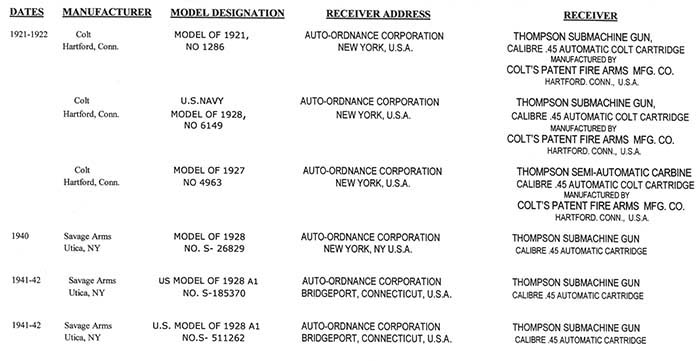
The Thompson Submachine Gun is probably one of the most recognized submachine guns in the world. Even non-enthusiasts are familiar the Thompson. There is however, a lot of confusion on actual manufacturers and other aspects of the guns, especially when the Auto-Ordnance name is mentioned. Adding to the confusion are the more recently manufactured full-auto Thompson guns that were produced by the modern Auto-Ordnance Corporation formerly of West Hurley, New York.
Former U.S. Army Ordnance officer John T. Thompson formed the original Auto-Ordnance Corporation in 1916 with the intent of developing a semi-automatic military rifle dubbed the Auto-Rifle. Work soon shifted to a one-man portable .45 ACP caliber machine gun, that was to become the famous Thompson Submachine Gun. While the famous submachine gun bears Thompson’s name, the weapon was actually designed by Oscar Payne, an employee of Auto-Ordnance. Auto-Ordnance’s Chief engineer, Theodore Eickoff, with the help of his staff, perfected the design into a working weapon. However, without the foresight and fortitude of John Thompson the gun would never have been conceived. The original Auto-Ordnance Corporation was simply a research and development organization, which had no manufacturing facilitates. The Warner and Swasey Company of Cleveland, Ohio manufactured all of the prototype weapons for the Auto-Ordnance Corporation. After a final production model was ready, the manufacture of the weapon was subcontracted out to Colt.
The Colt Thompsons
The very first production Thompsons were manufactured by Colt’s Patent Fire Arms Company of Hartford, Connecticut under contract with Auto-Ordnance from 1921 to 1922. These guns all have the Auto-Ordnance Corporation name and their New York, USA address roll-marked on the right side of the receiver. Also marked on the right side of the receiver near the center, are the patent dates of the Thompson. Early Colt guns have nine patent dates, while later manufacture Colt guns have three additional 1922 dates added. The left rear side of the receiver was marked to announce that Colt’s Patent Fire Arms Co. manufactured the gun, and the .45 ACP caliber of the gun (spelled calibre). The top of the receiver was marked with Auto-Ordnance’s “bullet” logo. Very early manufacture Colt guns under serial number 5000 used a bullet with the name AUT-ORD-CO inside of it. Subsequent receivers were marked with a narrower .30 caliber style bullet, which is often mistaken for an arrowhead, with the name THOMPSON inside of it written in script lettering.
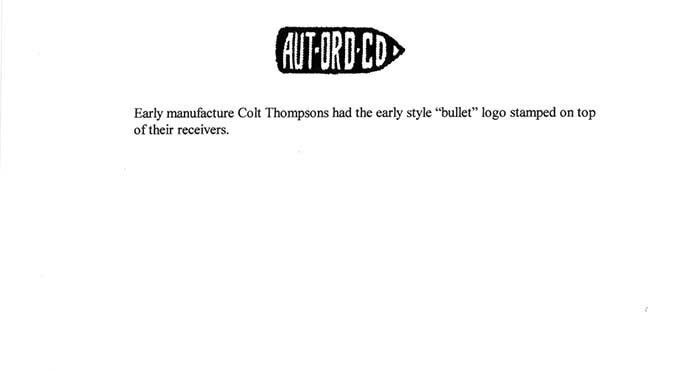
The model designation MODEL OF 1921 was marked on the left side at the center of the receiver. The serial number of the Colt Thompsons was stamped on the left side of the receiver as well as on the trigger frame. Some Colt guns had an additional serial number marked on the receiver under the grip mount. Most Colt guns were inspected and stamped with the initials JHB of John H. Barrett. There were several variations of the Colt Thompson, but all were made from existing 1921 Models, conceived after the initial production run had ended. The “new” models were introduced by Auto-Ordnance in an attempt to generate new interest and increase sales of the guns.
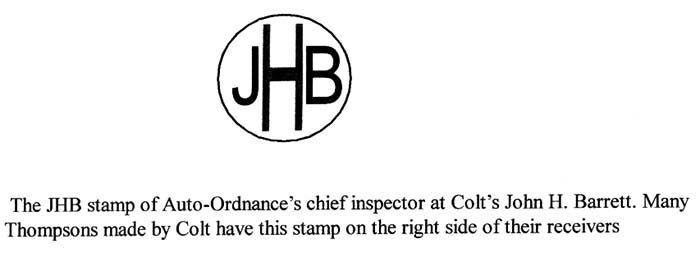
Because of lagging sales Auto-Ordnance introduced a semi-automatic-only version in 1927. The 1927 model was made by the conversion of existing 1921 model guns. Aptly named as the Model of 1927, there were some internal modifications made to eliminate the weapon’s full-automatic operation. The original SUBMACHINE GUN markings were neatly milled off of the gun and replaced with THOMPSON SEMI-AUTOMATIC CARBINE. The words “full auto” were also milled off of the selector markings.
Another variation was the 1928 Navy Model. These were 1921 models that were internally modified to lower the cyclic rate. The Navy guns had the numeral 1 in 1921 over stamped with an 8, and the nomenclature “US NAVY” added above the model designation. The “US NAVY” stamp was usually struck noticeably lighter than the other markings on the receiver. Many of the US NAVY marked guns were used for commercial sales.
World War II
In 1939 the Auto-Ordnance Corporation, now under the control of Russell Maguire, contracted with the Savage Arms Company of Utica, New York to manufacture the Model of 1928 “Like the one illustrated in Auto-Ordnance’s 1936 catalog”. Auto-Ordnance received its first contracts for the Thompson from France and Great Britain. These countries purchased the weapons directly from Auto-Ordnance with no U.S. government involvement. The first Savage manufactured Thompsons were delivered in April of 1940.
The Savage Model of 1928
The contract between Auto-Ordnance and Savage specifically stated that Savage was not to place their name on the Thompsons they manufactured. The early Savage manufactured receivers had Auto-Ordnance’s corporate name and New York, NY address roll-marked on the right side at the rear of the receiver, while the weapon’s thirteen patent numbers* were located at the center of the receiver’s right side. After A-O moved their operation to Connecticut the marking dies were changed to their new Bridgeport address. The Bridgeport address was located at the center of the receiver’s right side, and the patent numbers were moved to the rear of the right side. To date, the highest serial number 1928 model documented with Auto-Ordnance’s New York address has been S-75115, while the lowest serial number 1928 model recorded with a Bridgeport address has been S-83818. Somewhere in-between those two serial numbers the dies were changed to reflect the Bridgeport address of Auto-Ordnance. In addition to the receiver number, a duplicate serial number was stamped on the trigger frame.
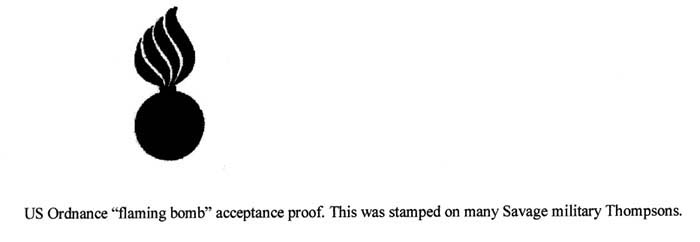
*Note; Colt guns had patent dates stamped on them, while Savage and Auto-Ordnance manufactured guns had patent numbers on their receivers. All of the 1921 Colt and all of the WWII 1928 and 1928A1 Thompsons had the word CALIBER spelled as CALIBRE on the left side of the receiver.
Most of the early Savage manufactured 1928 guns were sold to the British. These guns can be identified by a small British proof mark on the receiver and/or barrel. The receiver’s left side was marked “Model of 1928”. There were no U.S. acceptance or inspector’s stamps applied to the British contract guns.
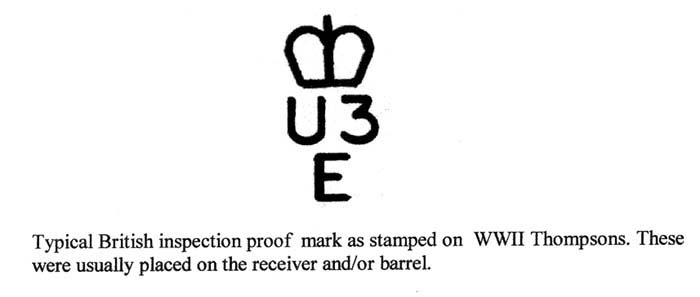
The Savage Commercial
There has been a lot of mystery and confusion regarding the so-called Savage Commercial Thompson. These guns were being made at the same time as the guns for the British contract and were used for the occasional police sales made by Auto-Ordnance in the 1940’s. They are the same as the British contract guns, except there are no British (or U.S. military) acceptance or proof marks on their barrels or receivers. Most of these guns had New York addresses on them, but there have been a few documented with a Bridgeport address.
The Savage U.S. Model of 1928 A1
The United States made the decision to provide military aid to the countries at war with the Axis powers, by passing the Lend Lease Act in March of 1941. Under this program the U.S. government was to take over all foreign contracts with U.S. companies supplying material for the war. One of the provisions of the Lend Lease Act was that all weapons provided under the program be U.S. marked. All future Thompsons would now be marked as U.S. Model of 1928 A1. Thompsons destined for Lend Lease that had already been built, had the U.S. marks added by hand stamping. After the United States entered the war Thompsons were procured by the thousands for U.S. forces, and these guns were virtually the same as the Lend Lease guns.
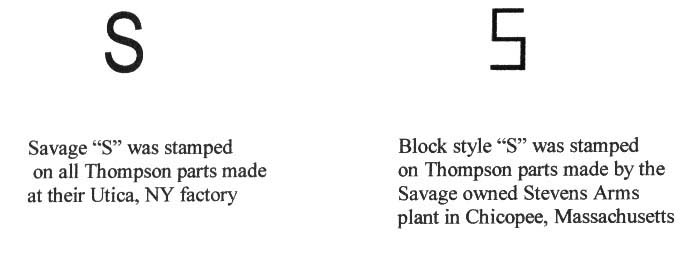
Early Savage 1928A1 Thompsons that were U.S. marked were stamped US without a period following each letter. The Savage receiver marking dies were changed at approximately the mid S-200,000 serial number range. The changes included the letters U.S. with a period after each letter, and all of the letters of the model designation were more uniform. Use of the new dies resulted in sharp, deeper struck markings than are seen on guns that were marked with the earlier dies.

After the U.S. government began procuring Thompsons, they implemented their own inspection procedures. All weapons were gauged and inspected to insure the guns met the government’s criteria. All Thompsons that passed the inspection process were stamped with the Ordnance Department’s “flaming bomb” stamp. The Ordnance Department’s “flaming bomb” acceptance stamp was superseded by a new Ordnance “crossed cannon” acceptance mark late in October 1942.

The U.S. Army Ordnance officer officially in charge of the entire weapon inspection process was designated as the Army Inspector of Ordnance or AIO. When an AIO’s initials were stamped on a firearm, it indicated that the weapon was accepted as U.S. property by the AIO on behalf of the U.S. Government. The Savage Thompsons were made in the Ordnance Department’s Rochester, NY district. The Army Inspector of Ordnance for the Rochester District were Lt. Colonel Ray L. Bowlin using the stamp, RLB from 1940, until 1942, and Colonel Frank J. Atwood from 1942 until 1945 using the stamp, FJA. Colonel Atwood assumed the position of AIO of the Rochester District near the end of the M1928A1 model production run. His initials are generally only seen on the M1 and M1A1 models.
All Savage manufacture receivers had the Auto-Ordnance “bullet logo” roll marked on the top. A few Savage 1928 models were marked “TOMMY GUN” on the top right of their receivers. This was done to fulfill a legal requirement to register the phrase as a trademark. All Savage manufactured Thompson receivers and frames were marked the GEG initials of Auto-Ordnance’s civilian inspector George E. Goll.
Next; Identifying the Auto-Ordnance, Bridgeport and the Auto-Ordnance, West Hurley Thompsons.
| This article first appeared in Small Arms Review V5N2 (November 2001) |











